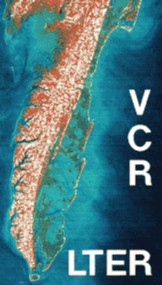 Tracing Early Diagenesis of Plant Organic Matter through Compound Specific Isotopic Analysis |

Mary Jo Geyer and Steven A. Macko
Department of Environmental Sciences
|
 Tracing Early Diagenesis of Plant Organic Matter through Compound Specific Isotopic Analysis |

Mary Jo Geyer and Steven A. Macko
Department of Environmental Sciences
|
Organic matter sources and diagenetic history of a sedimentary environment may be determined through chemical and isotopic characterization. Bulk analysis of the carbon-13 and nitrogen-15 stable isotopic signatures on a mass spectrometer can indicate the material originally deposited to the sediment. However, diagenetic alteration of compounds involving biological and non-biological reactions may modify the original source signal. Compound- specific isotopic analysis of components such as fatty acids provides a method for characterizing the organic geochemical history of an environment. Although different sources contribute specific distributions of compounds, simple chemical analysis is inadequate for source determination due to further alteration during early diagenesis. Therefore, fatty acid analysis by a gas chromatograph coupled with a combustion interface and an isotope ratio mass spectrometer (GC/C/IRMS) will allow reconstruction of the depositional and diagenetic events in a sedimentary environment.
The barrier islands on the Eastern Shore of Virginia offer unique ecosystems for the study of early diagenesis. Cores were taken in an inland pond located on North Hog Island in order to determine the source and diagenetic history of the environment. Bulk C and N isotopic signatures as well as fatty acid distribution patterns and isotopic values were determined downcore. Analysis of this data will yield deposition and diagenetic patterns consistent with the isotopic trends. Provided that consistent techniques and characteristic chemical and isotopic distributions can be established, the results of this study may provide a basis for comparison with polluted sediments to assess relative environmental health.